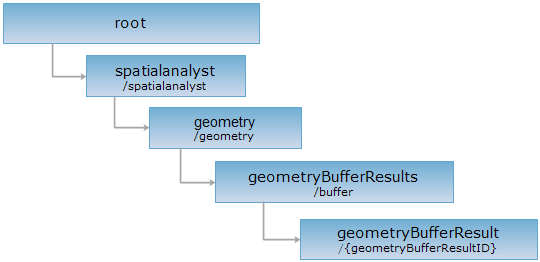
<geometryBufferResults_uri>/{geometryBufferResultID}[.<format>]
The geometryBufferResult resource is the result resource for buffer analysis.
Supported methods:
Supported output formats: rjson, json, html, xml.

Implement the GET request on the following URI, using rjson output format as an example to describe it, where, supermapiserver is the server name..
http://supermapiserver:8090/iserver/services/spatialanalyst-sample/restjsr/spatialanalyst/geometry/buffer/1.rjson
Gets the information about the buffer analysis result.
Normal response code(s): 200.
After implementing the GET request, the response parameters are as follows:
| Field | Type | Description |
| succeed | boolean | Whether the buffer analysis is successful. Returns true if successful; otherwise, returns false. |
| image | ImageResult |
The image resulted from the spatial analysis. The result image and the description about the imge are represented. |
| message | String | The related information generated during the buffer analysis process. |
| resultGeometry | Geometry | The result geometry. |
After implementing the GET request, the response in rjson format is as follows:
{
"image": null,
"message": null,
"resultGeometry": {
"id": 0,
"parts": [11],
"points": [
{
"x": -77,
"y": 23
},
{
"x": -44.08203932499369,
"y": -51.161984870956616
},
{
"x": 33,
"y": -76.498743710662
},
{
"x": 110.08203932499369,
"y": -51.16198487095663
},
{
"x": 143,
"y": 23
},
{
"x": 124.3733471206735,
"y": 81.12381937190963
},
{
"x": 114.3733471206735,
"y": 95.12381937190963
},
{
"x": 32.99999999999999,
"y": 137
},
{
"x": -48.3733471206735,
"y": 95.12381937190965
},
{
"x": -58.3733471206735,
"y": 81.12381937190963
},
{
"x": -77,
"y": 23
}
],
"style": null,
"type": "REGION"
},
"succeed": true
}
Gets the operations and content format supported by resource.
Asks for the response identical to the one that would correspond to a GET request, but without the response body. This is useful for retrieving meta-information written in response headers, without having to transport the entire content. The meta-information includes the media-type, content-encoding, transfer-encoding, content-length, etc.
The HEAD request helps check the existence of the geometryBufferResult resource and whether it can be accessed by the client. By implementing the HEAD request on the URI, with .<format> appended to the end, we can quickly get to know whether the geometryBufferResult resource supports the representation in <format> or not.